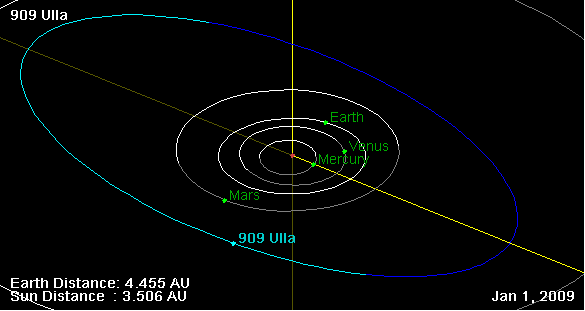909 Ulla
 Orbital diagram of Ulla | |
| Discovery [1] | |
|---|---|
| Discovered by | K. Reinmuth |
| Discovery site | Heidelberg Obs. |
| Discovery date | 7 February 1919 |
| Designations | |
| MPC designation | (909) Ulla |
Named after |
Ulla Ahrens (observatory donor) |
|
1919 FA · 1936 SJ 1949 OF1 · 1949 PW 1966 BU · 1966 DM A912 CA | |
|
main-belt · (outer) [2] Ulla · Cybele | |
| Orbital characteristics [3] | |
| Epoch 23 March 2018 (JD 2458200.5) | |
| Uncertainty parameter 0 | |
| Observation arc | 99.05 yr (36,179 d) |
| Aphelion | 3.8651 AU |
| Perihelion | 3.2265 AU |
| 3.5458 AU | |
| Eccentricity | 0.0901 |
| 6.68 yr (2,439 d) | |
| 61.654° | |
| 0° 8m 51.36s / day | |
| Inclination | 18.789° |
| 146.35° | |
| 233.14° | |
| TJupiter | 3.0240 |
| Physical characteristics | |
Mean diameter |
113.13±1.48 km[4] 116.44±2.4 km[5] |
| 8.73 h[6] | |
|
0.0343[5] 0.037[4] | |
|
Tholen = X [3][2][7] B–V = 0.689[3] U–B = 0.279[3] | |
|
8.65[2][8] 8.95[1][3][4][5] | |
|
| |
909 Ulla, provisional designation 1919 FA, is an asteroid from the outermost regions of the asteroid belt, approximately 116 kilometers (72 miles) in diameter. It is the namesake of the Ulla family which belongs to the larger group of Cybele asteroids. It was discovered on 7 February 1919, by German astronomer Karl Reinmuth at the Heidelberg Observatory in southwest Germany.[1] The X-type asteroid has a rotation period of 8.7 hours. It was named after Ulla Ahrens, daughter of a friend of the discoverer.[9]
Orbit and classification
Ulla is the parent body of the Ulla family,[10] a very small asteroid family of less than 30 known bodies.[11] It orbits the Sun in the outermost asteroid belt at a distance of 3.2–3.9 AU once every 6 years and 8 months (2,439 days; semi-major axis of 3.55 AU). Its orbit has an eccentricity of 0.09 and an inclination of 19° with respect to the ecliptic.[3]
Naming
This minor planet was named after Ulla Ahrens, a daughter of a friend of the discoverer.[9] Karl Reinmuth also named the asteroid 950 Ahrensa for the Ahrens family, who was a donor of the Heidelberg Observatory. The official naming citation was mentioned in The Names of the Minor Planets by Paul Herget in 1955 (H 50).[9]
Physical characteristics
In the SMASS classification, Ulla is a X-type asteroid.[3][7]
Rotation period
A rotational lightcurve of Ulla was obtained from photometric observations in 2000. Lightcurve analysis gave a rotation period of 8.73 hours with a brightness amplitude between 0.13 and 0.24 magnitude (U=3).[6] Other photometric period determinations gave concurring results.[8][12]
Diameter and albedo
According to the surveys carried out by the Infrared Astronomical Satellite IRAS and the Japanese Akari satellite, Ulla measures between 113.13 and 116.44 kilometers in diameter and its surface has an albedo between 0.034 and 0.037.[4][5] The Collaborative Asteroid Lightcurve Link uses an albedo of 0.0450 and derives a diameter of 116.66 kilometers based on an absolute magnitude of 8.65.[2]
References
- 1 2 3 "909 Ulla (1919 FA)". Minor Planet Center. Retrieved 7 July 2018.
- 1 2 3 4 "LCDB Data for (909) Ulla". Asteroid Lightcurve Database (LCDB). Retrieved 7 July 2018.
- 1 2 3 4 5 6 7 "JPL Small-Body Database Browser: 909 Ulla (1919 FA)" (2018-02-27 last obs.). Jet Propulsion Laboratory. Retrieved 7 July 2018.
- 1 2 3 4 Usui, Fumihiko; Kuroda, Daisuke; Müller, Thomas G.; Hasegawa, Sunao; Ishiguro, Masateru; Ootsubo, Takafumi; et al. (October 2011). "Asteroid Catalog Using Akari: AKARI/IRC Mid-Infrared Asteroid Survey". Publications of the Astronomical Society of Japan. 63 (5): 1117–1138. Bibcode:2011PASJ...63.1117U. doi:10.1093/pasj/63.5.1117. Retrieved 7 July 2018. (online, AcuA catalog p. 153)
- 1 2 3 4 Tedesco, E. F.; Noah, P. V.; Noah, M.; Price, S. D. (October 2004). "IRAS Minor Planet Survey V6.0". NASA Planetary Data System – IRAS-A-FPA-3-RDR-IMPS-V6.0. Bibcode:2004PDSS...12.....T. Retrieved 7 July 2018.
- 1 2 Lagerkvist, Claes-Ingvar; Erikson, Anders; Lahulla, Felix; De Martino, Mario; Nathues, Andreas; Dahlgren, Mats (January 2001). "A Study of Cybele Asteroids. I. Spin Properties of Ten Asteroids". Icarus. 149 (1): 190–197. Bibcode:2001Icar..149..190L. doi:10.1006/icar.2000.6507. Retrieved 7 July 2018.
- 1 2 De Prá, M. N.; Pinilla-Alonso, N.; Carvano, J. M.; Licandro, J.; Campins, H.; Mothé-Diniz, T.; et al. (September 2018). "PRIMASS visits Hilda and Cybele groups" (PDF). Icarus. 311: 35–51. arXiv:1711.02071. Bibcode:2018Icar..311...35D. doi:10.1016/j.icarus.2017.11.012. Retrieved 7 July 2018.
- 1 2 Gonano, M.; di Martino, M.; Mottola, S.; Neukum, G. (December 1990). "Physical study of outer belt asteroids". Space dust and debris; Proceedings of the Topical Meeting of the Interdisciplinary Scientific Commission B /Meetings B2: 197–200. Bibcode:1991AdSpR..11..197G. doi:10.1016/0273-1177(91)90563-Y. ISSN 0273-1177. Retrieved 7 July 2018.
- 1 2 3 Schmadel, Lutz D. (2007). Dictionary of Minor Planet Names – (909) Ulla. Springer Berlin Heidelberg. p. 81. ISBN 978-3-540-00238-3. Retrieved 7 July 2018.
- ↑ "Asteroid 909 Ulla". Small Bodies Data Ferret. Retrieved 7 July 2018.
- ↑ Nesvorný, D.; Broz, M.; Carruba, V. (December 2014). "Identification and Dynamical Properties of Asteroid Families" (PDF). Asteroids IV: 297–321. arXiv:1502.01628. Bibcode:2015aste.book..297N. doi:10.2458/azu_uapress_9780816532131-ch016. Retrieved 7 July 2018.
- ↑ Behrend, Raoul. "Asteroids and comets rotation curves – (909) Ulla". Geneva Observatory. Retrieved 7 July 2018.
External links
- Asteroid Lightcurve Database (LCDB), query form (info)
- Dictionary of Minor Planet Names, Google books
- Asteroids and comets rotation curves, CdR – Observatoire de Genève, Raoul Behrend
- Discovery Circumstances: Numbered Minor Planets (1)-(5000) – Minor Planet Center
- 909 Ulla at AstDyS-2, Asteroids—Dynamic Site
- 909 Ulla at the JPL Small-Body Database
